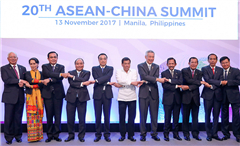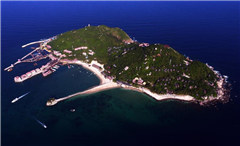Against anti-globalization wave, China champions greater economic integration in East Asia
2017-11-14
Xinhua
MANILA — Despite the rise of an anti-globalization sentiment and trade protectionism worldwide, China has been rooting for greater and deeper economic integration in East Asia.
Addressing the 20th ASEAN-China, Japan and South Korea (10+3) leaders’ meeting on Nov 14, Premier Li Keqiang urged advancing the construction of an East Asia Economic Community (EAEC) to promote regional integration and common development.
FORGING AN ECONOMIC COMMUNITY IN EAST ASIA
Since its establishment 20 years ago, the 10+3 cooperation has been improving and expanding. Today, it is now one of the most sophisticated and fruitful cooperative mechanisms in Asia, contributing to peace, stability, development and prosperity of East Asia, Premier Li said.
China hopes that the leaders can build consensus at the meeting and show their firm support for regional integration and the construction of the EAEC to root for an open world economy, the Premier said.
East Asia, which has weathered two financial crises, is now the world’s most dynamic and promising region in terms of development. Last year, it accounted for 44 percent of the world’s economic growth, he observed.
Establishing the EAEC is a strategic goal of the 10+3 cooperation and accords with the long-term fundamental interests of the people in this region, Premier Li said.
Given the rise of an anti-globalization sentiment, the Premier said it is time to push for the construction of an economic community in East Asia to make the region an important engine of global economic recovery.
The Premier stressed that the envisioned EAEC should be built under two principles. ASEAN should be in a central position, and the “ASEAN way”, featuring consensus through consultation, openness and inclusiveness, and accommodating each party’s comfort level, should be followed.
The 10+3 cooperation is the main channel for promoting the EAEC, Premier Li said.
The community should also be established on the basis of ASEAN’s cooperative mechanism with China, Japan and South Korea respectively, and supplement other subregional frameworks such as the Lancang-Mekong Cooperation and the East ASEAN Growth Area (BIMP-EAGA), he added.
SIX-PRONGED PROPOSAL
To build the EAEC, Premier Li called for enhanced cooperation in six areas — trade, investment and productivity capacity, infrastructure, finance, sustainable development, and people-to-people exchanges.
“We should advance trade liberalization and facilitation to gradually achieve the ultimate goal of a single market,” Premier Li said, calling for expanding the scope of opening-up.
He suggested establishing a customs clearance cooperation mechanism in East Asia to better promote cross-border e-commerce.
In addition to traditional industries like textile, household appliances, building material and metallurgy, Premier Li called for strengthening investment cooperation in emerging industries, such as the digital economy, smart economy, green economy, and shared economy.
The Premier also proposed to jointly build a 10+3 service alliance for small and medium enterprises.
“China stands ready to better align the Belt and Road Initiative with the Master Plan on ASEAN Connectivity 2025, and discuss making a master plan on East Asia connectivity,” Premier Li said.
He proposed to jointly build a regional financial cooperation system for safeguarding the region’s financial stability.
The benefits of the EAEC, he suggested, should be shared by all countries, taking into account the concerns of underdeveloped ones and disadvantaged groups.
China, he added, is willing to share its experiences in poverty reduction with other countries.
In addition, the Premier called for expanded cultural and people-to-people exchanges to deepen mutual understanding and friendship, and create a greater sense of community.
SPEEDING UP CHINA-JAPAN-SOUTH KOREA FTA
The Premier also called for speeding up China-Japan-South Korea free trade agreement (FTA) negotiations.
“China stands ready to work with relevant parties to speed up China-Japan-South Korea FTA negotiations, taking a more active part in promoting negotiations on the Regional Comprehensive Economic Partnership, so as to achieve the long-term goal of the Free Trade Area of the Asia-Pacific,” Premier Li said.
The FTA negotiations were launched in November 2012. The 12th round was held in Tokyo this April.
The meeting on Nov 14 was chaired by Philippine President Rodrigo Duterte and attended by regional leaders including Japanese Prime Minister Shinzo Abe and South Korean President Moon Jae-in.
The leaders spoke highly of the significance of the 10+3 cooperation in promoting economic and social development in the region and welcomed China’s initiatives on boosting the mechanism.
The leaders said they stood ready to take the 20th anniversary of the 10+3 cooperation as an opportunity to plan for the future and advance the building of the EAEC.
In particular, they agreed to expand their cooperation in infrastructure, trade and investment, finance, technological innovation and people-to-people exchanges.
A statement on food security cooperation by the 10+3 leaders, jointly proposed by China and Thailand, was released after the meeting.
Premier Li is in Philippine capital Manila for an official visit to the country and a series of leaders’ meetings on East Asia cooperation.


